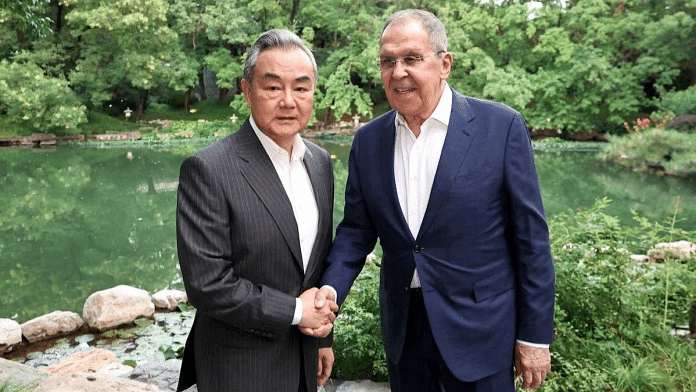New Delhi: China and Russia kicked off the latest edition of their bilateral naval exercise, Joint Sea-2025, on Sunday in the Sea of Japan near Vladivostok, Russia.
The multi-domain drills come just two days after U.S. President Donald Trump claimed that he had ordered two nuclear submarines to be deployed to “the appropriate regions”, in response to ‘inflammatory’ remarks by former Russian president Dmitry Medvedev.
Despite the proximity in timing, China’s Ministry of National Defence said that the exercise had been planned beforehand.
This also follows Trump’s announcement of an 8 August deadline for Russian President Vladimir Putin to end the war in Ukraine or face further punitive tariffs. Trump also imposed a 25% tariff on Indian exports last week, citing India’s longstanding defence ties with Russia and continued purchases of Russian oil.
China’s Ministry of National Defence has said that the drills would last three days and include complex operations such as submarine rescue, joint anti-submarine warfare, air defence, anti-missile engagements and maritime combat. Live-fire artillery exercises are also being conducted to validate planning and coordination achieved during pre-exercise training.
The ministry added that participating Chinese vessels include the guided-missile destroyers Shaoxing and Urumqi, the comprehensive supply ship Qiandaohu and the submarine rescue ship Xihu.
From the Russian side, the Udaloy-class destroyer Admiral Tributs serves as the flagship, joined by diesel-electric submarines and maritime aviation units from both countries.
Following the exercises, China and Russia will also conduct joint naval patrols in “relevant waters of the Pacific”, according to Beijing’s defence ministry. These coordinated activities reflect expanding naval interoperability in sensitive maritime zones, including those near Japan and Taiwan.
Senior Colonel Zhang Xiaogang, spokesperson for China’s Ministry of National Defence, emphasised in a briefing on 30 July that the exercise forms part of the annual cooperation plan between the two militaries. “It is not targeted at any third party, nor is it related to the current international and regional situation,” he said.
While China maintains it is a neutral party, it has avoided calling for Russia to withdraw troops and frequently criticises the West for fuelling the conflict by supplying arms to Kyiv. Many of Ukraine’s allies, including the United States, believe that China has supported Moscow throughout the war.
Since signing a “no-limits” strategic partnership in early 2022, just before Russia launched its invasion, China and Russia have routinely held joint military exercises designed to enhance coordination and project deterrence to rival powers.
Also read: Will Russia & China back Iran after US strikes? They’re quiet, calculating allies
A long arc of coordination and power projection
China and Russia’s formal defence cooperation began in the early 2000s, with Peace Mission 2005, the inaugural large-scale joint land, sea and air war games held on China’s Shandong Peninsula under the framework of the Shanghai Cooperation Organisation (SCO).
The Joint Sea naval exercises were launched later, in 2012, as a dedicated bilateral initiative, with the first edition taking place in the Yellow Sea. The annual maritime manoeuvres, typically involving one to two dozen warships in total, have occurred in more diverse locations than the primarily ground-focused Peace Mission exercises.
In 2015, Russia and China staged a two-phase joint naval drill, first in the Mediterranean Sea and then, months later, in the Sea of Japan. The 2017 edition took place in the Baltic Sea, the first time that People’s Liberation Army Navy (PLAN) warships conducted manoeuvres in that region. Last year’s edition was held along the southern coast of China.
The binational naval exercises have practised an increasingly varied set of operations, including maritime search and rescue, joint air and anti-submarine warfare, combined air defence, freeing ships seized by pirates, escorting civilian vessels and ongoing cargo replenishment.
In what may become a pattern, China and Russia in recent years have also begun jointly conducting naval drills with additional countries, such as Iran and South Africa.
Last year alone, the two nations conducted a record 11 joint military exercises, the highest number in a single year. In addition to seven naval drills, the same year saw their first joint naval patrol in the Arctic Ocean and their inaugural coast guard mission.
(Edited by Viny Mishra)
Also read: Distracted Russia is losing central Asia to China






